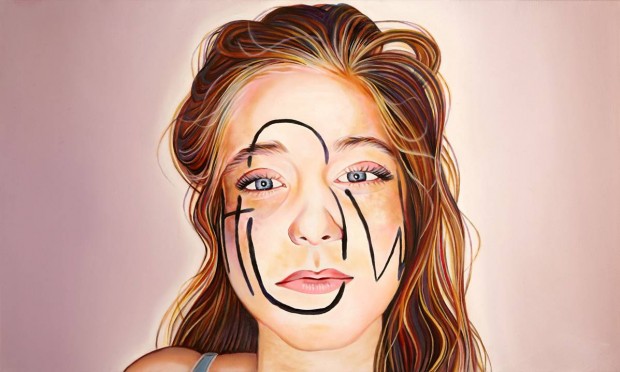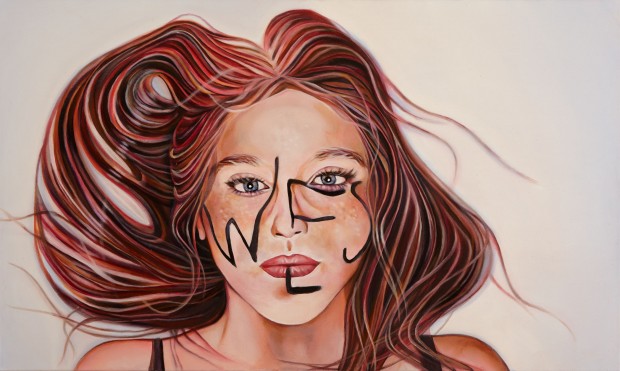













How can we survive?
Amina Broggi
Vernissage, Freitag, den 24. Mai 2013, 19 bis 21 Uhr
Dauer der Ausstellung: 25. Mai bis 22. Juni 2013
Die in Wien lebende Künstlerin Amina Broggi befragte Jugendliche, die kurz vor ihrem Schulabschluss stehen, ausführlich nach den Dingen, die sie derzeit am meisten bewegen. Das Ergebnis, das schließlich auch zum Titel der Ausstellung wurde, ließ sich in der Frage zusammenfassen: How can we survive? Daraus entstanden Bilder der Erotik und des Erschreckens, wie so oft, wenn sich die Künstlerin der Porträtmalerei zuwendet. Da sind Porträts von wunderschönen jungen Frauenköpfen, um die sich Faschingsschmuck einmal wie eine enge Kappe um das Gesicht, einmal wie ein barocker Kragen um den Hals legt. Sie kehren Gefühle der Dargestellten nach außen und weisen subtil auf eine innere, zwiespältige Befindlichkeit hin. Amina Broggi hat sie als Objekte „fremddekoriert“, lässt sie durch die Papierschlangen eingeengt und innerlich zwiespältig erscheinen, eben „unsustainable“, wie der Titel des Bildes mit den Faschingsschleifen um den Hals beschreibt. Wie eine Faschingsmaske wirkt auf einem anderen Porträt weiße Schokolade, die über das Gesicht einer jungen Frau fließt. Auf einer weiteren Leinwand derselben Größe (200 x 140 cm) blickt ein Auge den Betrachter durchdringend an. Es wirkt keineswegs nur martialisch, obwohl sich die Komposition auf ein Close up der linken Augenpartie beschränkt, die mit einer jugendstilähnlichen Gittermaske eher ent- als verhüllt ist. Und wie meistens in ihren Serien geht die Künstlerin noch einen Schritt weiter: Frischhaltefolie als Maske im Faschingstreiben, die zweckentfremdet einmal den Blick einer Frau trübt, einmal in Mundverbot ausartet. Amina Broggi spiegelt in ihren hyperrealistischen Bildern wie in der letzten Ausstellung „human kind“ Emotionen. Abgründiges und Verletzungen hinter der Fassade sind ihr Thema. Nach Interviews mit Jugendlichen, die ihr seit ihrer Kindheit bekannt sind, entstanden die Einzel- und Gruppenporträts von zwei jungen Frauen und zwei jungen Männern, auf deren Gesichter Buchstaben des Satzes „how can we survive?“ wie „Initialen“ gemalt sind. Als wollte die Künstlerin sagen: für diese jungen Leute hat sich das Leben noch nicht entschieden. Das ist die gute Botschaft.
Die 1980 in Altstätten in der Schweiz geborene und in Fürstentum Liechtenstein aufgewachsene Künstlerin Amina Broggi studierte an der Universität für angewandte Kunst in Wien. 2007 erhielt sie ihr Diplom. Sie lebt und arbeitet in Wien und Berlin. Zahlreiche Ausstellungen, darunter 2005 „Real – Junges Österreich“ Kunsthalle Krems, 2005 „emerging artists: hotspots“, Sammlung Essl, Klosterneuburg, 2007 „exitus. tod alltäglich“, Künstlerhaus Wien, derzeit: 8. März bis 16. Juni Stipendium Vordemberge-Gildewart, Kunstmuseum Vaduz, Liechtenstein.
How can we survive?
Amina Broggi
Opening reception, Friday, May 24, 2013, 7—9 p.m.
Duration of the exhibition: May 25—June 22, 2013
Prior to her latest series of works, Vienna-based artist Amina Broggi extensively questioned high school students on the verge of graduation about the issues that currently most affected them. The result, which then became the title of the exhibition, can be subsumed in the question: how can we survive? The works that Broggi created in this context are charged with eroticism and horror, as is often the case with the artist’s portrait paintings. Thus one finds portraits of the heads of beautiful young women around which carnival decorations have been wound either in the shape of a tight cap framing the face or as a baroque collar encircling the neck. These works transpose the feelings of those depicted into the external sphere, subtly pointing to an inner, ambivalent sensibility. Amina Broggi has decorated these human figures “extrinsically” like objects, letting them appear constrained through the paper streamers and somehow at odds with themselves. They are literally “unsustainable,” as the painting of the carnival streamers enclosing the neck describes the scene. In another portrait, white chocolate is “flowing” across the face of a young woman like a carnival mask. On another canvas of the same size, an eye is piercingly gazing at the viewer. Yet, this definitely is far from having an exclusively martial effect, although the composition is limited to a close-up depiction of the left-hand area of the eye, which is veiled rather than revealed by an art nouveau-style latticed mask. As is the case in the majority of her series, the artist goes still one step further: plastic wrap is misemployed as a mask in the course of carnival activities, which in one composition obscures a woman’s view and in another seals a person’s mouth. In a manner similar to her previous exhibition human kind, in her hyper-real paintings Amina Broggi mirrors emotions. The abysses and injuries hidden behind façades are her dominant theme. Following long interviews with the youngsters whom she has know since their childhood, she painted portraits of two young women and two young men, rendering these in individual representations and in a group portrait. The individual words of the sentence „How can we survive?“ appear on their faces like initials, as if the artist wanted to say: life has not yet made up its mind about these young people. This might be seen as a positive message.
The artist Amina Broggi was born in 1980 in Altstätten, Switzerland, and grew up in the Principality of Liechtenstein. She studied at the University of Applied Arts Vienna, where she received her diploma in 2007. She lives and works in Vienna and Berlin. Her work has been shown in numerous exhibitions, among these Real— Junges Österreich at the Kunsthalle Krems (2005), emerging artists: hotspots (2005), Sammlung Essl, Klosterneuburg, exitus. tod alltäglich (2007), Künstlerhaus Wien, and is currently presenting her work from March 8 to June 16, 2013, in connection with the Vordemberge-Gildewart stipend at the Kunstmuseum Vaduz, Liechtenstein.
